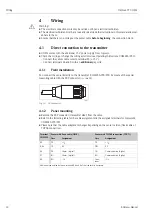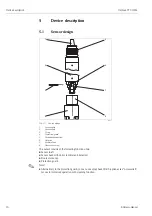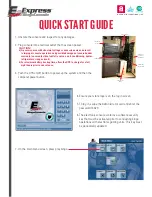
Safety instructions
Oxymax W COS61
4
Hauser
1
Safety instructions
1.1
Designated use
The oxygen sensor is suitable for continuous measurement of dissolved oxygen in water.
Typical applications are:
• Measuring, monitoring and regulating the oxygen content in activated sludge basins.
• Monitoring the oxygen content in the sewage treatment plant outlet.
• Monitoring, measuring and regulating the oxygen content in public waters and fish farming
water.
• Monitoring of oxygen enrichment in drinking water.
Any other use than the one described here compromises the safety of persons and the entire
measuring system and is, therefore, not permitted.
The manufacturer is not liable for damage caused by improper or non-designated use.
1.2
Installation, commissioning and operation
Please note the following items:
• Installation, electrical connection, commissioning, operation and maintenance of the measuring
system must only be carried out by trained technical personnel.
The technical personnel must be authorized for the specified activities by the system operator.
• Technical personnel must have read and understood these Operating Instructions and must
adhere to them.
• Before commissioning the entire measuring point, check all the connections for correctness.
Ensure that hose connections are not damaged.
• Do not operate damaged products and secure them against unintentional commissioning. Mark
the damaged product as being defective.
• Measuring point faults may only be rectified by authorized and specially trained
personnel.
• If faults cannot be rectified, the products must be taken out of service and secured against
unintentional commissioning.
• Repairs not described in these Operating Instructions may only be carried out at the
manufacturer’s or by the service organization.
1.3
Operational safety
The sensor has been designed and tested according to the state of the art and left the factory in
perfect functioning order.
Relevant regulations and European standards have been met.
As the user, you are responsible for complying with the following safety conditions:
• Installation instructions
• Local prevailing standards and regulations.





































